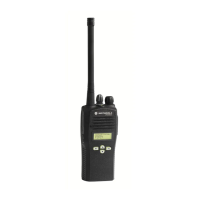68009328001-A December, 2009
Radio Alignment Procedures: Utilities 5-15
5. Adjust the input level to reflect the next softspot value. Repeat steps 3 and 4 to tune the next
value.
5.5.4 RSSI Display Tuning
1. Under the Rx Align menu, select RSSI Display Tuning.
2. Inject an on channel signal to the radio at -47 dBm at the frequency listed. Modulated the signal
with a 1 kHz tone at 60% deviation (3 kHz) to verify the radio is receiving the desired frequency.
RSSI tuning is only done at 25 kHz channel spacing.
3. Change the level to that which is needed to produce 12 SINAD (approximately -119 dBm).
4. Press the Update button for the softspot to be tuned to the RSSI value correlating to the applied
level. The programmed RSSI value will be displayed.
5. Adjust the input level to -90 dBm.
6. Press the Update button for the softspot to be tuned to the RSSI value correlating to the applied
level. The programmed RSSI value will be displayed.
5.6 Utilities
5.6.1 Program Serial No.
The Program Serial No. option under the Utilities heading allow the radio serial number to be
programmed. However, the serial number of a particular radio can only be programmed if it was
originally blank. If the serial number of the radio was not blank, then access to the screen will be
denied.
5.6.2 Temp Comp Data Read
The Temp Comp Data Read command will read the Temp Compensation data out from the radio
and then display it on a dialog screen. The data displayed is in 4-byte Hexadecimal form, i.e. 0-9,A-
F. e.g. A5 E9 33 3A.
5.6.3 Temp Comp Data Write
The Temp Comp Data Write command will write user Temp Compensation data into the radio. The
user will then be presented with a dialog screen of the temp comp data to commit/write into the radio.
The Temp Comp data can be keyed in manually by the user as 4-byte Hexadecimal form.
5.7 Radio-to-Radio Cloning
1. Cloning is the process of copying the content of one radio (source radio) into another radio
(destination radio). Radio content refers to system-type features such as frequency, squelch type
options, trunking, etc.
Radio functionality inherent in one radio cannot be cloned to another radio that does not contain the
same functionality. Tuning and alignment information are not transferable and are not affected by
cloning.
1. Signaling Identification Numbers (IDs) are duplicated in the cloning process. Unique IDs may be
assigned with the CPS.
Note:
The source radio’s serial number cannot be blank.
Note:
Unsuccessful cloning attempts generates a continuous tone and may be an
indication that the destination radio’s codeplug is corrupted.

